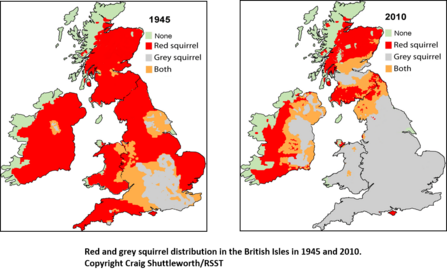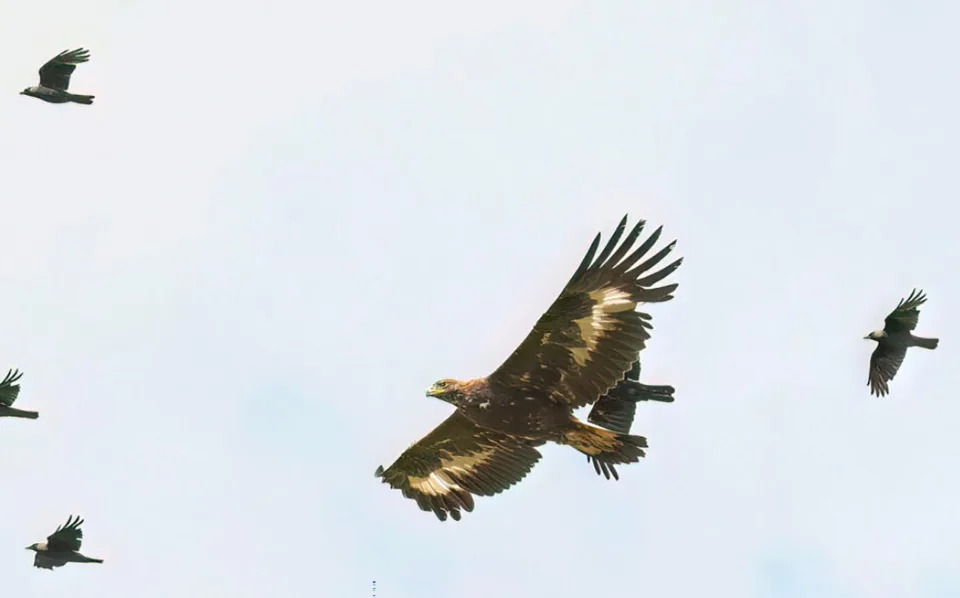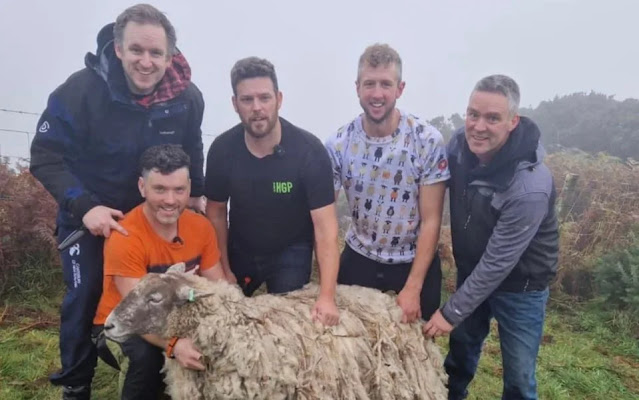It appears that people are still spreading the same old dogma because (a) it's easier to copy and paste and (b) humans MUST have a species that it can scapegoat for its own actions.
Enter the grey squirrel and the badger. In the case of the badger it is being eradicated from the UK countryside so that in a few years it will be a rarity. 250,000 killed so far and up to 60,000 per year killed by cars. Bad animal management practices are to blame for bovine TB and unless you are mentally deranged you will have been made aware at some point that there is no science behind the killing of badgers. A number of sources evenb state that badgers "became a scapegoat species in the 1970s".
In A Field Guide To The Carnivores Of The World by Luke Hunter (Panthera, London, 2011) it is stated (p. 164):
"Persecuted as a pest and for illegal 'baiting' with terriers. Controversially culled as a carrier of bovine tuberculosis (bTB) in the UK, despite strong evidence that culls do not reduce incidence of the disease. Red List"
Red List means that it is considered an endangered species and, of course, in the UK it is 'protected' by the same body (DEFRA/Natural England) that pays shooters a lot of money to go out and kill them. Scientifically if eradicating a supposed cause of disease has no effect then it is clear that said suspected cause is innocent. In the UK it has been suggested t6hat infected cattle can pass bTB to badgers and vice versa but there is no proven source and some data featured in reports seems inconsistent with facts. In Bovine Tuberculosis in Britain and Ireland – A Perfect Storm? the Confluence of Potential Ecological and Epidemiological Impediments to Controlling a Chronic Infectious Disease a paper by A. R. Allen, R. A. Skuce, and A. W. Byrne (2018) it is stated that:
"Even with such heterogeneity of approach across time and national boundaries, it remains startling that particularly in Britain, which came close to achieving eradication in the 1960 and 1970s bovine TB is resurgent "
There is mention of low, medium and high density badger populations which, frankly, showed that the authors were unaware of badgers in the UK. 250,000 have been killed and in some areas there are badger free zones where the population has been wiped out. There is still bTB. If anything there are only what can be described as low or medium density badger populations and on top of that some 65,000+ badgers are killed on the roads each year and an unknown number snared, shot or baited. High density populations is a fantasy.
One question the authors do not mention, they are after all looking at dairy cattle, we have large urban badger populations and they have been at established locations for many decades if not a century or more (many village badger setts are now part of larger cities and towns) and yet...where are all the deer coming down with bTB? Every dead badger I have recorded in the Bristol Badger deaths Register is the victim of a car or lorry. With larger "densities" of badgers why are we not seeing bTB sweeping through our gardens and parks?
Reading the paper it almost seems as though the authors are about to claim bad animal husbandry but step back -after all don't want to upset dairy farmers and their in pocket politicians. We had BSE of course and know the cause there:
"A cow gets BSE by eating feed contaminated with parts that came from another cow that was sick with BSE. The contaminated feed contains the abnormal prion, and a cow becomes infected with the abnormal prion when it eats the feed. If a cow gets BSE, it most likely ate the contaminated feed during its first year of life."
In fact quite a lot of farmed animal diseases are down to contaminated foods and bad animal husbandry -some of the most outright and illegal things farmers were guilty of was during the UK BSE outbreak when cattle were moved around and infected cattle moved to other areas. In effect bad animal husbandry combined with problems in the food production side of things contributed and still does to many farm animals. Another aspect may be the genetics of cows bred and the type of cow we see in fields today are completely different to the old British types that were seen as more rugged and hardier.
How does bTB get into cattle in an area where there have never been any badgers? Another good question is why there is never any bTB testing of the badgers killed in culls and WHY are we prevented from carrying out such post mortems by the UK Health and Safety Executive "because of the risk of bovine TB"?
Then we have the Grey squirrel.
Humans introduced the grey squirrel mainly as a novelty specimen for estates and menageries. As with other human interferences with nature an unnatural evolution took place. What they like to call the "survival of the fittest" -though this is only applied when it is an animal humans want to encourage for some reason. In this case 'sporting shooting'
Another truth is that humans -game keepers, country squires and the wood industry have been trapping, snaring, poisoning and shooting red squirrels for a long time ("shooting a few brace before lunch" -"brace" being a pair- was a little bit of 'fun sport'.
From 1977 until DEFRA attempted to stop my being a Partner Against Wldlife Crimes (PAWS) in 2015 (police forces do still consult me) I had to speak to pest controllers, game keepers, estate managers, farmers and estate owners and one after another would refer to the "pests" or "vermin" they had to take care of and one of these was the red squirrel. "Why the squirrels?" I would ask. "Vermin" was the response 99% of the time but the other 1% found it a "fun shoot". I soon became aware that local authorities, DEFRA and the police were turning a blind eye using a few down pat excuses about private property etc. Red squirrels are classed a endangered and even the Young Peoples Trust For the Environment continues the lie of the grey menace
https://ypte.org.uk/factsheets/squirrel-red/territory
In 1945 there was a huge red squirrel population compared to that of the grey as this map from Wildlife Trusts demonstrates https://www.wildlifetrusts.org/saving-species/red-squirrels

Red and grey squirrels distribution in the British Isles in 1945 and 2010. © Craig Shuttleworth/RSST
Before we get on to the next question it has to be pointed out that the reds of the late 19th century on are not the Old British red squirrels that were decimated by hunting in the mid 19th century and "new stock" was imported to continue the 'fun'.
So how did the Greys start winning so much territory from the Reds and why? Simple; following the as outlined in The Gazette https://www.thegazette.co.uk/all-notices/content/102333
"The Forestry Commission was founded to restore the nation’s timber reserves in the wake of World War 1. Here's how 100 years of forestry has helped to shape our landscape.
In September 1919, the first Forestry Act, which created the Forestry Commission and recognised the importance of forestry to the UK, came into force.
The beginnings
By the end of World War 1, the UK’s timber supply was much depleted. Britain’s forests had already suffered a steady decline since the Middle Ages, and the additional strain of the war – especially trench warfare – left the nation’s woodlands in a state of disrepair.
From a countryside that was once largely forest, just 5 per cent of tree cover remained, and urgent action was required to address growing concerns.
In 1918, the Acland Committee reported to then prime minister, David Lloyd George, that an organisation with state backing would be the most effective way of restoring and restocking the nation’s forests.
On 1 September 1919, the Forestry Act came in to force, establishing the Forestry Commission and granting it responsibility to look after woods across England, Scotland, Ireland and Wales (Gazette issue 31837).
By Christmas of the same year, the first Forestry Commission trees had been planted at Eggesford in Devon, turning the tide for post-war woodlands, and paving the way for the future of forestry in Britain.
Post-war planting
In the years that followed, the Commission was given the confidence and freedom to focus on acquiring and planting new woodland. Hundreds of thousands of acres were planted, but more turbulent times lay ahead.
As tensions mounted across Europe, the Commission had to draw up felling plans in the event of another war. The Forest of Dean and New Forest were hit hardest, and while scores of trees were felled, the Commission continued to expand; growing its workforce and planting more forests.
The subsequent decades witnessed a dramatic increase in productivity for the Commission, as forests were expanded due to fuel demand for a burgeoning timber trade.
Technologies and mechanical equipment simultaneously improved, alongside a growing awareness of public recreation needs, and the importance of conservation for wildlife and the environment.
Woodland grants schemes, which had existed since the formation of the Commission, evolved and provided different incentives. These included awards for broadleaf planting, and for landowners who considered public access"
Despite all the talk of preserving red squirrel habitat the one thing officials and various organisations keep quiet about is "the squirrel as a pest" -damage to young saplings and mature "timber" -business and estates lose money. Get rid of the squirrels while 'protecting' habitats (until the wood there is needed).
The Grey squirrel is often cited as the "perfect example" of what authorities like to term "invasive species" and these need "eradication" (killing). Odd that the red squirrel population is stabilising and not just due to the mass killings of grey squirrels. Greys have found towns and gardens far better habitats -bird feeders and a very wide selection of foods.
Bird watchers tend to hate red and grey squirrels as "nest robbers" and a few of these people relish killing grey squirrels (and where they can out of sight reds). Today you will see the RSPCA telling you it is okay to trap and kill grey squirrels as well as other online sources stating that if you catch one you must kill it and vets (who mainly have no interest in wildlife as it does not bring in money) presented with a grey squirrel with even a minor ailment will not question the law and will kill it.
Humans introduced grey squirrels centuries ago while wiping out red squirrels and it is about time that the hunting term "vermin" as well as the money making (for pest controllers) term "pests" were dropped. In the year 2300 are we still going to see non stop killing of a species that is for all intents and purposes native?
hunting wiped out a lot of deer to the point that in the 1800s more had to be imported from Europe (hence DNA showing EU deer). They wiped out hares and imported more from Europe. Otters -ditto. Wild cats also. In fact, wild cats being released, hares, any number of deer with EU DNA, foxes, beaver on and on and on -all foreign species imported and released so invasive species?




















.jpg)